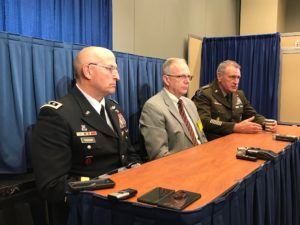Top Army officials leading the service’s modernization push said Wednesday operating under an extended continuing resolution into 2020 could alter the timeline of major programs, such as hypersonic weapon development, and hinder efforts to improve outreach with small business.
Leadership from the Army’s acquisition office and Futures Command told reporters at the Association of the United States Army conference in Washington the effects of the current short-term CR can likely be mitigated while urging a budget deal to avoid potentially adding years to impending program starts.

“We pretty much anticipated a short CR. So most of the programs were built that way in terms of getting things started in 2019 so you don’t have a new start,” Gen. Mike Murray, head of Army Futures Command, said Wednesday. “If we get much past a short-term CR, it’s easier to list the programs that won’t be affected.”
Congress passed a CR to keep the government open through at least Nov. 21. While the move locks in defense spending at last year’s funding levels, it effectively halts the Army from starting new programs and moving forward on procurement increases.
Army Secretary Ryan McCarthy told reporters on Monday the Army may lose upward of $7 billion in buying power under an extended CR (Defense Daily, Oct. 15).
Lt. Gen. Neil Thurgood, lead official for the Army hypersonics effort, noted a CR that extends past Jan. 1 2020 would cause adjustments to the development plan for the Long Range Hypersonic Weapon (LRHW).
“In this particular case this year, we anticipated that there would be a CR. So we think that we’re in a really good position until around the 1st of the year. We don’t think we have any impacts up until then,” Thurgood said. “If the CR gets extended, then we’re going to have to change the outcome. We’re going to have to adjust things programmatically.”
The Army recently awarded contracts to Lockheed Martin [LMT] and Dynetics for work on LRHW, as it pushes toward an initial flight test in 2021 and plans to field a residual combat capability in FY ’23 (Defense Daily, Aug. 30).
Thurgood said his team should be able to keep certain items of hypersonic development on track, while having to slow down others to free up dollars to keep the program moving forward.
“At the end of the day, the allocation of dollars from Congress is critical for us. A CR is always a [deviation] to that base plan,” Thurgood said.
Bruce Jette, the Army’s top acquisition official, said a CR is likely to push small businesses away from working with the Army while the service is unable to start new programs, many of which he said require the innovative capabilities being developed by non-traditional partners.
“By putting a CR in place, you’re hurting small businesses from being able to enter the defense industry sector and from being able to bring in new ideas for at least a year or two after that,” Jette said. “CR’s cause us to end up shrinking our industrial base.”
Futures Command has looked to bolsters its engagement with small business, with a recent GAO report recommending the command improve outreach by developing measures for tracking partnerships with small businesses and coordinating with other organizations on utilizing these companies to bolster research and development efforts (Defense Daily, July 17).
“I already have difficulty trying to keep young businesses, new businesses coming into the fold and being part of the family. They know that if I have a great idea today it may take me as much as two years to get anything into the budget so that I can move that program forward. Small companies can’t last two years. If I start throwing CRs on top of that, then they say ‘look, I can’t deal with this,’” Jette said.